This morning began as a usual Monday here at the labs. I rolled out of bed and stumbled to breakfast, half asleep and hungry as always. It was a gorgeous day, the sun was shining and it reflected off of the water in the harbor. After breakfast, I meandered back to S1, preparing my mind for the arduous, yet thoroughly interesting day ahead. The syllabus hinted that we would be diving in the realm of bioacoustics which I worried would be saturated with physics, a subject that most days just goes right over my head. Class began shortly, and it didn’t take long for those physics terms to start popping up. A few hours ticked past and it was nearing 11:00 am. We were diligently listening to Scott lecture on sound waves, when Robin made a sudden, dramatic exit from the room. She hurried out the door and disappeared, only to scurry back inside ten minutes later shouting, “There are orcas in Friday Harbor!” I have never seen eight people drop everything so fast. Laptops and notebooks were flying through the air as we ran excitedly out of S1 and down toward the harbor. It was as if our lives depended on seeing these whales. My heart was beating so fast, I hardly noticed the treacherous rocks we sprinted over to spot the whales. As we reached the edge of the island, what looked like four orcas could be seen swimming North out of Friday Harbor. Among the blows and the dives, I caught glimpses of a juvenile whale with the others. Words cannot express how utterly and deeply I was affected by my first sighting of these amazing creatures, the killer whales. They only took a short time to be out of our visual range, but they will forever be imprinted in my memories. What a grand day!
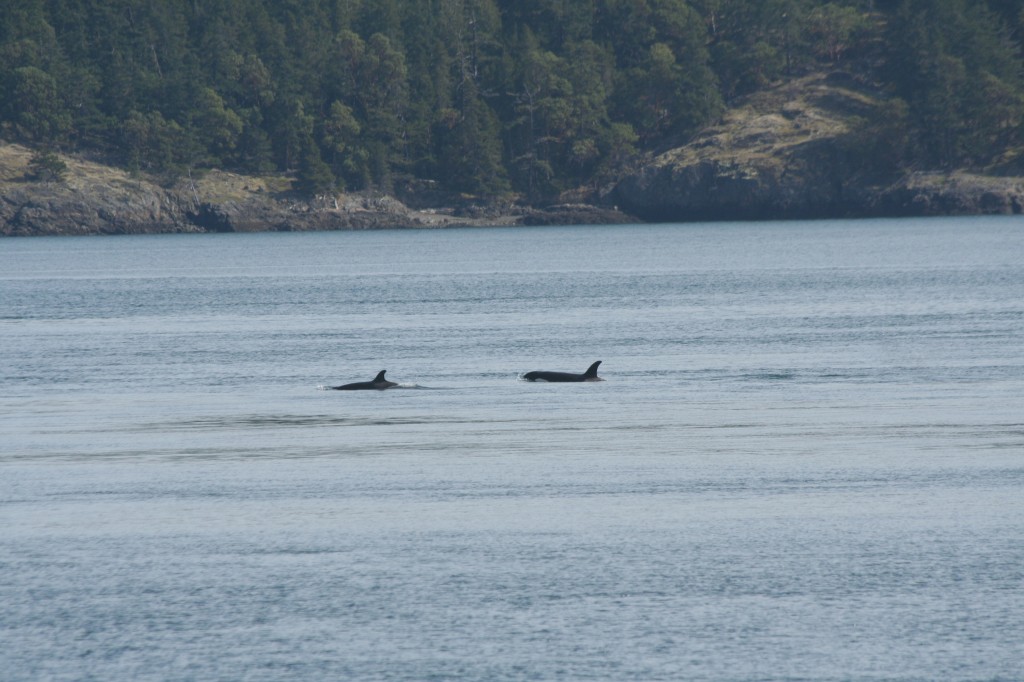
Orcas in Friday Harbor!!!!
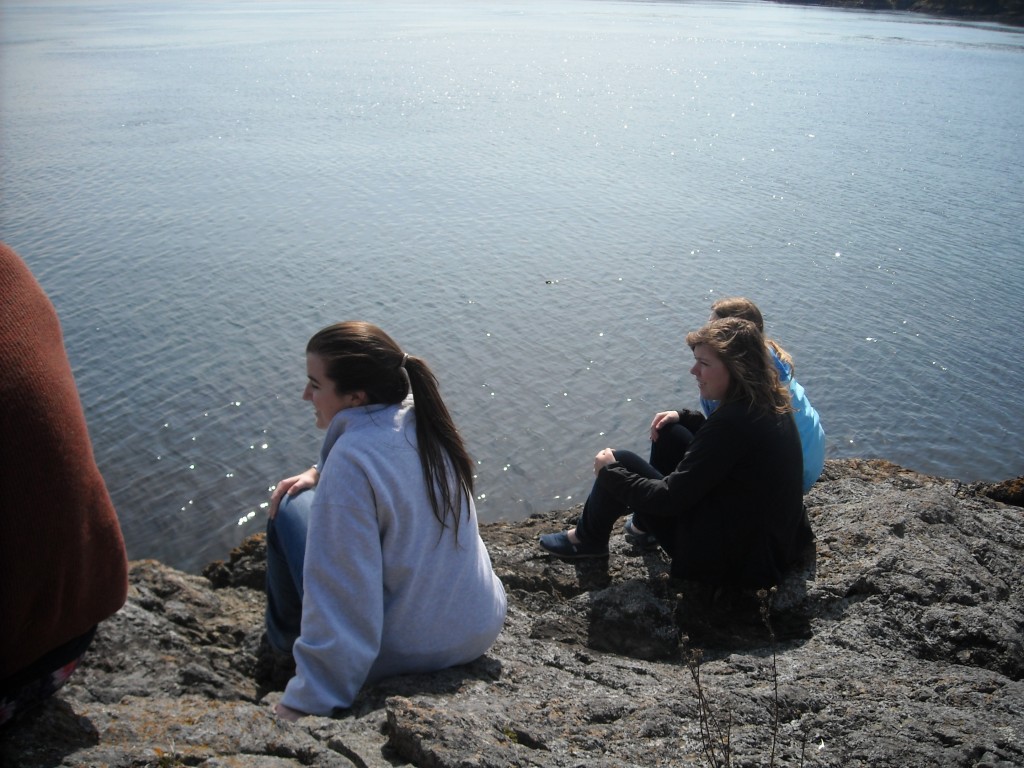
Watching the Whales
Read More
The Friday Harbor Labs have a number of trails to explore, that weave and wind through the woods behind the labs. Rachel, Taya, and I decided to go explore some these trails one afternoon. As we were walking down muddy trail we spied a small tunnel that appeared to lead through a thicket. After bushwhacking through the gnarled tunnel, which had more thorns than we had anticipated, we emerged onto a breathtakingly beautiful meadow that overlooked the ocean. This was no ordinary meadow, it was the kind of meadow that you go to on a sunny day to make daisy chains. The ground was covered in a thick layer of emerald green moss that gently hugged us as we sat on it. Below the blissful meadow lay a small beach covered in soft rounded pebbles that made a pleasant clacking sound as we walked over them. As the sun began to sink lower in the sky it started to dawn on us that we had to get back to the trail. We didn’t want to go through the tunnel because it was unpleasant enough the first time. We decided to head due west towards the trail. Our zigzagging path through the woods took us on an adventure full of thorns and laughter. Hopefully next time we go to our amazing spot in the woods we can find a better way to get there!
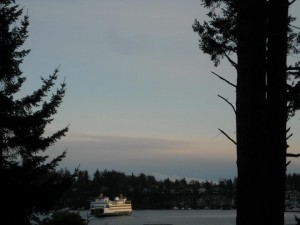
This past week in class we each read and discussed a paper on sustainable fisheries. I chose a case study that evaluated the environmental impact of different varieties of feeds used at salmon farms. The main goal of this study was to determine if organic salmon feed had less of an environmental impact than the conventional salmon feed. The study used four different types of salmon feed. The LCA methodology was used to evaluate the environmental impact of each feed. Each ingredient was assessed on its environmental impacts from cradle-to-grave. They found that the organic ingredients outperformed the conventional ingredients in every category except ecotoxicity. This article really helped me grasp just how big of an impact farmed fish have on the environment. A good way to further the study would be to test the health impacts of organic vs. conventional  feed on the salmon.
Link to Feeding Farmed Salmon: Is Organic Better?
http://www.fcrn.org.uk/sites/default/files/Feeding_farmed_salmon_-_is_organic_better.pdf
Read More
My case study for this week centered on reducing bycatch of juvenile red snappers by shrimp trawls in the Gulf of Mexico. The paper is: Designing marine reserves to reduce bycatch of mobile species: a case study using juvenile red snapper (Lutjanus campechanus), by Diamond et al.

Red snapper from the Gulf of Mexico
The research team made use of geographic information system (GIS) to map fishery-independent trawl surveys done by the Southeast Area Monitoring and Assessment Program (SEAMAP) every summer and fall in the Gulf of Mexico from 1987 to 1997.
The paper attempts to asses whether there is a geographic pattern to the distribution of juvenile red snappers.
Diamond et al. analyzed juvenile red snapper distribution and examined “hot spots†with high concentration (intensity) and the predictability for the hotspot to reoccur in the same position over time (persistence). In designing marine reserves, one could designate no-trawling zones according to the desired level of intensity and persistence which correspond to percent or numerical bycatch-reduction goals.
In further consideration, given that red snappers are highly mobile and higher-intensity hotspots are often unpredictable, a no-trawling zone does not need to be permanent. Ideally, such a no-trawling zone could be fluid from year to year, in order to avoid trawling in higher-intensity hotspots.
For a no-trawling zone to be fluid, it would depend on how effectively this information could be disseminated in a timely manner. This could also apply to marine vessel no-go zones in the activity range of Southern Resident Killer whales. In the San Juan community, dissemination of information should be relatively easy due to wide availability of communication technology.
Read More
It is amazing how quickly a strange place full of unfamiliar faces can begin to feel like home. This experience only continues to get better.
In class this past week we looked at ecosystems from the “bottom upâ€. In a brief description, this means that you study ecology from the bottom of the food chain up to the top, examining the ecological differences in tropic levels. Combining this newer topic while still emphasizing sustainability science, we discussed case studies that look at sustainable fisheries.
My case study was “An ecosystem based approach for Alaska groundfish fisheriesâ€. I found this particular paper to be especially interesting because it focuses on managing fisheries from the perspective of the ecosystem instead of focusing on the economic benefits. The Alaskan groundfish fisheries management is known for being progressive and fairly sustainable. The total annual catch has been at 2 million tones for the last 20 years, an impressive statistic. The National Pacific Fishery Management Council wanted to include all aspects into the management process including: public participation, scientific research, comprehensive monitoring, gear restrictions, habitat conservation areas, and more. Conservative catch limits are highly emphasized and the total annual catch is always less than what the environment can sustain. This is a cautionary approach to fisheries management. The two aspects of the management plan that was most impressed with were the Marine Protected Areas and the examination of Marine Mammals and Seabirds. The Marine Protected Areas allocate specific locations that are important to the ecosystem and ban fishing from these areas, or lower the catch limits. This approach also takes into consideration the fisheries impacts on marine mammals and seabirds. Lowering by-catch rates, and decreasing negative interactions between the animals and the fishing boats are two of the goals for this aspect of system. I found this “ecosystem†approach to fisheries to be interesting and insightful. One important thing that I took away from our discussion of this paper is that although the management reports appear to be purely positive, every system has its downfalls.
Fisheries are incredibly important to understand right now in the world of killer whale
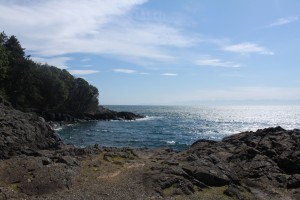
Perfection
conservation. We know that a lack of prey, specifically Chinook salmon, can have a huge impact on the population dynamics of the Southern Resident killer whales. Discussing a variety of fisheries management systems helped me have a better understanding of the current debates about salmon abundance and health here in the Pacific Northwest.
Yesterday we were lucky enough to have beautiful weather again. We spent our day off adventuring to Lime Kiln lighthouse and found a wonderful view atop the kiln itself. I never know what to expect here, this place has a way of surprising you all the time, but I am loving every minute of this adventure.
Read More
Fortunately we have been able to spend a large proportion of our time this week outside basking in the Washington sunshine. Although thunderstorms were predicted at the beginning of the week, the forecasts seem like a distant memory. Many hours have been spent this week staring out across Haro Strait in search of the ever elusive whales. We know that they are out there because we can hear them on the hydrophones. A few fortunate folk have even caught glimpses of them as they have passed by nearby inlets (not us).  Throughout the San Juans, there is a network of researchers, whale watching boats, and whale heads who keep tabs on the whales and there whereabouts. It is only going to be a matter of time before we see them for ourselves (I can feel it).  Today, there were sporadic reports of transients throughout the Strait, and so a few of us decided to try and hitch a ride across the island to Lime Kiln. Hitch hiking is apparently a popular and efficient way to get around the island. In fact, there are designated pick up areas specifically for hitch hikers. It did not take long before the first vehicle stopped for us. On arrival to Lime Kiln we were greeted by an influx of tourists who were making the most of their Easter Weekend. Sadly no whales.  We did however spot one river otter foraging in the shallows. We were later joined by other students from FHL (mostly the Zoobot crowd). As we imparted our whale knowledge with the Zoobots, they in turn shared facts about various intertidal invertebrates. Such an interesting crowd!
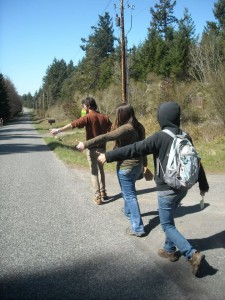
Hitchhikers Guide to San Juan
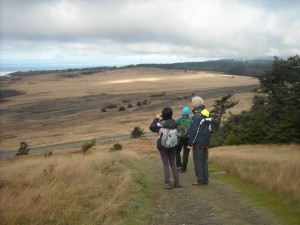
Taking in the view
We also explored numerous locations on the south side of the island including Cattle Pass, and South Beach. Cattle Pass is a really unique site where the shallow sea floor forces great quantities of water through a small channel. Thus, the area experiences strong currents which attract an array of sea birds and marine mammals. We were able to test out our birding skills from land-based observations (we still need a bit of work on identifying certain species). Another great reason for visiting Cattle Pass was that it was referenced in one of the papers we were required to read for this week. In addition, to get better views (180 degrees) of the surrounding area, we hiked up Mount Finlayson. This got me thinking about how great of a vantage point the hill would be for viewing whales as they swam by. Â On the evening, we returned to the south side of the island to have a bonfire with some friends. The full moon cast its beautiful hues over the beach and out across the water. Splendid evening!
On the academic front, we were given the opportunity to present on a paper that identified bottom-up effects. At a basic level, ‘bottom-up effects’ refers to how the population density of a resource affects the population density of that resources’ consumer. Although most people chose to present on marine-related issues, I wanted to focus on a terrestrial case study. My paper was titled ‘Bottom-Up Effects on Persistence of a Specialist Predator: Ant Invasions & Horned Lizards’. This paper discussed in detail the effects of invasive species on native populations. In my selected case study, a population of coastal horned lizards was being impacted by the introduction of the Argentinean ants to the area. These ants were destroying and out competing the ‘normal’ food source of the lizard. The lizards are ‘sit and wait predators’, and have highly specialized diets. Because of this, they cannot, or are unwilling, to switch to an alternative food source. On reading this, I couldn’t help but notice the similarities between the horned lizards and the SRKW who depend on one species of salmon, the Chinook, despite the abundance of other species in the area. A second paper I discussed this week was titled ‘Management Effectiveness of the World’s Marine Fisheries’. This paper sought to evaluate how management affects fishery sustainability. I was particularly interested to read how sustainability was defined, and also how it was measured. The blend of science and policy made for a good paper. On the topic of good papers, Andrea Buckman and Cara Lachmuth (DFO Scientists) came in to present on their past research. Cara’s presentation on ‘Killer Whale Exposure to Engine Exhausts’ raised some interesting questions, highlighted gaps in existing data, and drew attention to potential areas of future study. The two guest lecturers also sat in on our weekly mentor meetings, offering advice and giving examples of how we can expand on our final research projects. This was greatly appreciated!
Read More
So this week we were able to observe a harbor seal necropsy which is essentially a dissection but since we’re biologists we gave it a fun name. Once I got past the smell and the obvious fact that they were cutting open a baby seal it was fascinating. If you have a particular fascination with all things grotesque you can check out Rachel’s blog for a picture. Its pretty cool I’d check it out. While nothing could really compete with getting an inside look at a harbor seal it’s been a pretty good week. We’re preparing for our data collection at the Lime Kiln lighthouse and starting to narrow down our ideas for research projects, which is much harder than I initially though it would be, there’s just so much to ask. We also travelled to Mount Finlayson which was a bit of a hike, but totally worth it as it gave us a great view of cattle pass and the surrounding waters at the southern tip of San Juan Island.
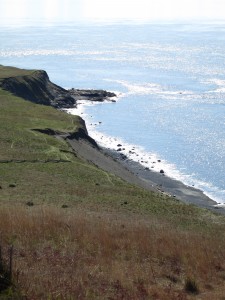
In the meantime we’ve been continuing our work in the classroom and combining our interests and the class theme of sustainability. We were responsible for finding another case study but this time about sustainable fishery practices which was right up my alley, being a fisheries major and all. So I looked at a paper titled Estimating mortality of Atlantic bluefin tuna in an experimental catch-and-release fishery. I think its a requirement that all research papers have an excessively long title. The paper looked at the potential to create a catch-and-release fishery to limit fish mortality. Studies have been done on why people fish and the most often reason is the social bonding experience. Often times its a family tradition passed down from generation to generation, so this way people can still have that experience while conserving the tuna population. The study sought to simulate the proposed regulations of the fishery to get results that would resemble what might happen on the boat. The researchers caught 60 fish and managed to tag 59 of them with PATs which are pop-up archival tags. These tags include microchips with a sensor, transmitter and float. They can measure temperature and depth and are preprogrammed to release from the fish and float to the surface after a certain amount of time or death of the fish. The results show that only 2 fish died, and 4 tags didn’t successfully transmit. The rest of the fish survived except for one. If you noticed earlier I said they caught 60 and tagged 59. So that one was killed during the fight after the fish was hooked. There was an overall mortality rate of  5.1% which is much better than 100% if I do say so myself. I think this is a terrific idea, but much needs to be done before it will be successful. I would love to see them do another study with a greater sampling range of at least over 100 animals to get more accurate results. This type of fishing would also take strong leadership on the boat and experienced anglers. However I love that people are trying to find ways to combine human and environmental interests so that we can enjoy the things we do now for a long time to come.
Read More
Class began today on somewhat of a different note than usual. We observed a necropsy of a harbor seal, performed by veterinarian Joe Gaydos, which was thoroughly fascinating! The newly weaned, stranded male seal was rescued on a beach and was found with an injury just above its nose, which we later discovered had penetrated through the bone. The young seal was blind in both eyes, and it was speculated that the injuries had resulted in an attack from another harbor seal. It was determined that the extent of its injuries would not allow it to thrive in the open ocean if it was returned, so instead it was euthanized, as this was the fairest option. As unfortunate as it may have been for that poor little seal, it was extremely educational and beneficial for us to have been able to witness its necropsy.
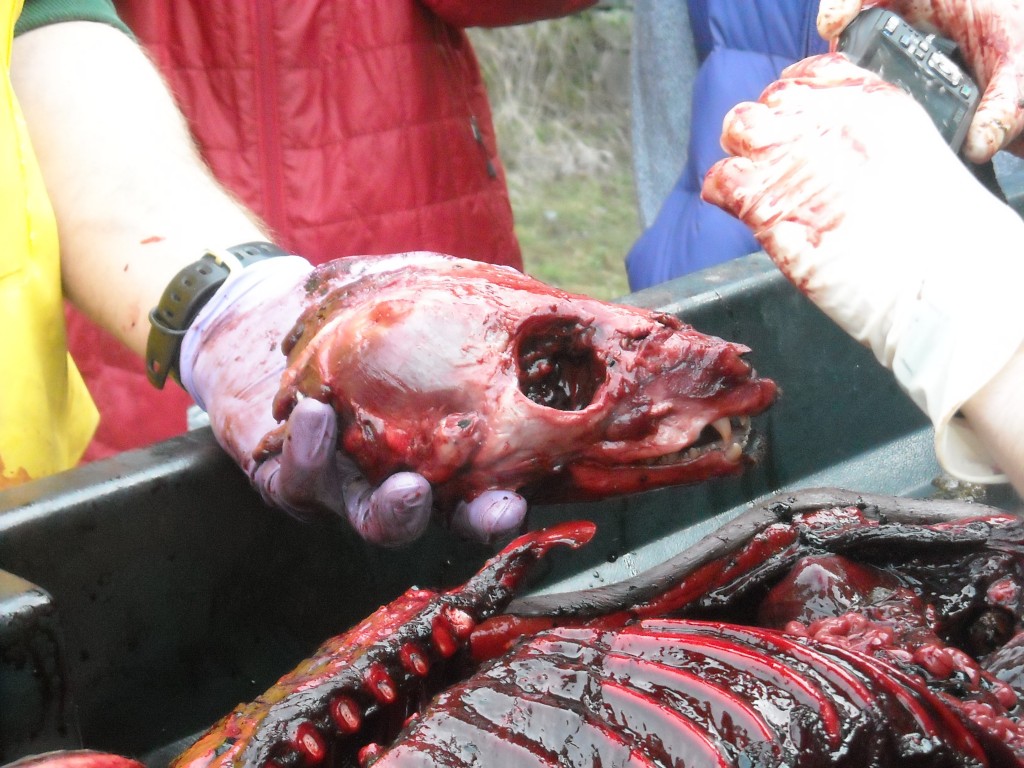
Harbor Seal Skull
Throughout the dissection, there was a great deal of education occurring that snagged at my light physiology background. It was fascinating to see each internal part of the seal accompanied by a brief explanation of what role it played in a living animal. I took an unholy amount of photos, as my interest in possibly becoming a marine mammal veterinarian was weighing heavily on my mind throughout the necropsy. I was bummed that we were unable to stay for the next necropsy candidate, a river otter, but I am so enthused about being able to have such an awesome experience!
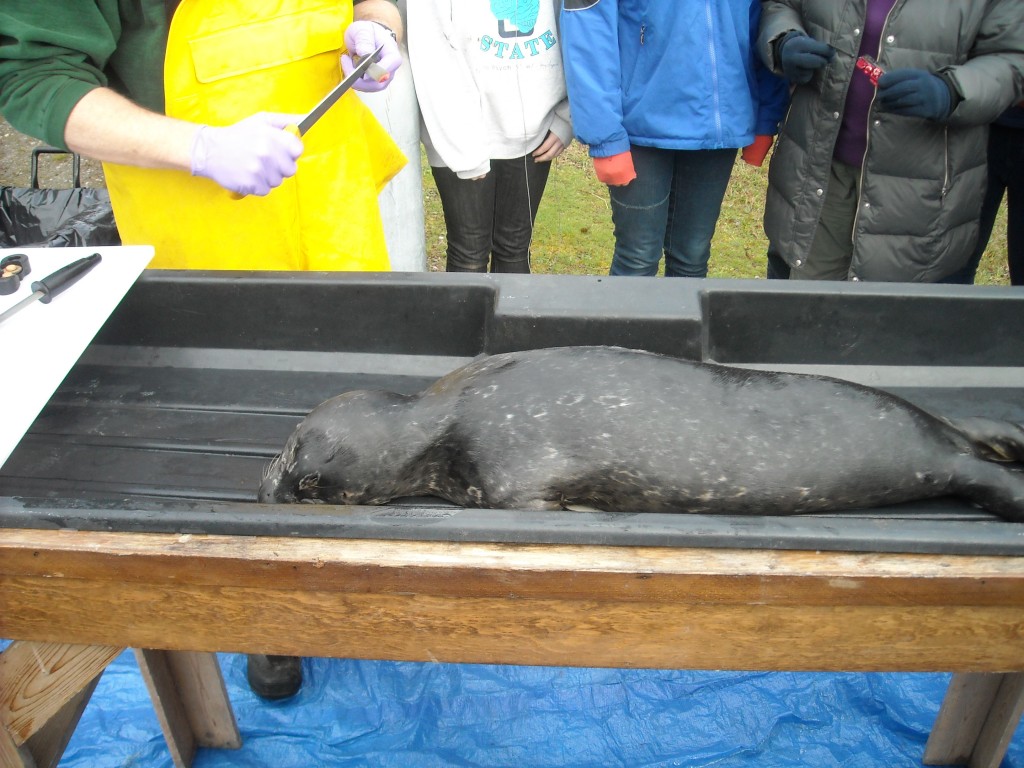
Just Before the Necropsy
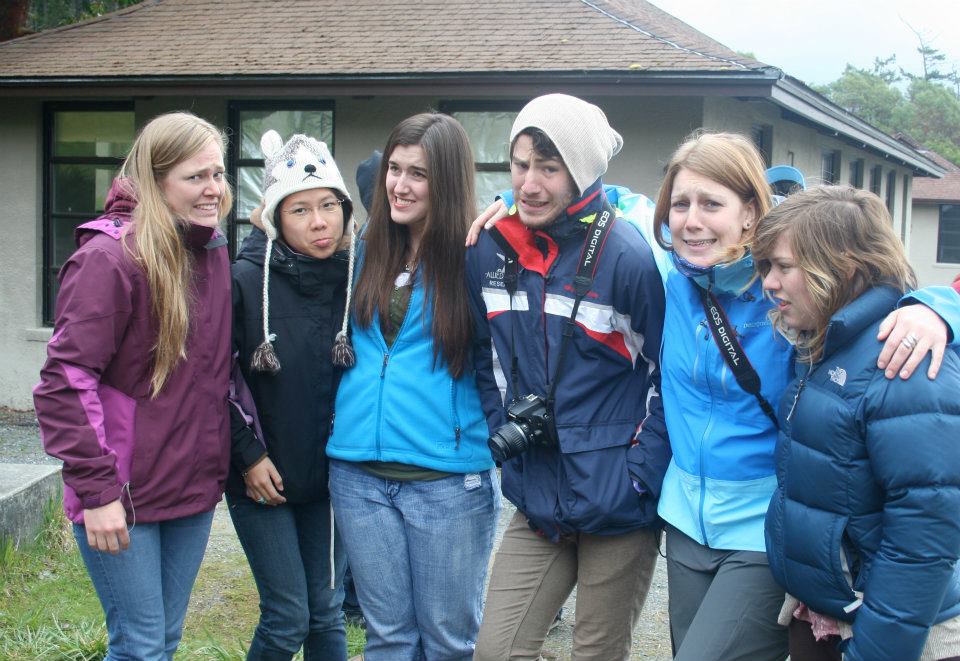
We Survived the Necropsy
Our mid-week adventure to South Beach was tremendous! South Beach, as you may have assumed from the name, is on the South end of San Juan and encompasses American Camp, which is basically the same thing as English Camp, but where the Americans settled so many years ago. It hosts an array of creatures that we were very fortunate to see, from tremendous terrestrial animals, like foxes and bald eagles, to amusing sea birds and harbor seals. The weather was fabulous, sunny and calm; it was optimal marine mammal viewing weather! Unfortunately, the whales were still being rather evasive and we didn’t spot any out in the water.
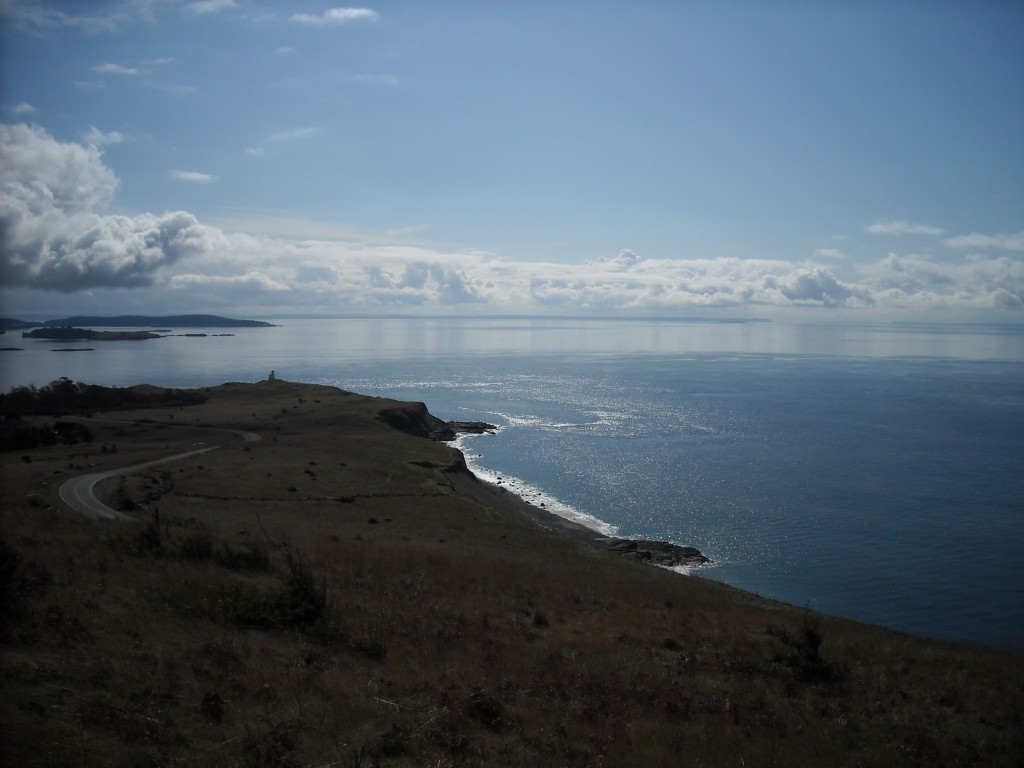
A view of South Beach
Our class time and studies have been enabling us to learn a tremendous amount about the ocean and its incredible inhabitants. I read another case study that dealt with the question of whether or not marine areas protected for ecosystem conservation are compatible with marine areas designed for fishery sustainability. The study focused on the importance of the sea otter’s role in the ecosystem and its relationship to the harvested red abalone, its main source of food, and how the red abalone population was being affected by the sea otters, sustainable harvesting, or both. The results of the study indicated that the sea otters were more detrimental to the red abalone than sustainable, recreational harvesting. When both factors were observed occurring in the same area, the red abalone population was affected adversely. Therefore, it was determined that ecosystem conservation and sustainable fishing are not compatible in this specific situation. I found the results of this study to be really intriguing because it ended with a push for another study, to find compatibility of ecosystem conservation and sustainable fishing. It is satisfying when a study results in an expected conclusion, but if it leaves the door open for more thought provoking research, it becomes so much better!
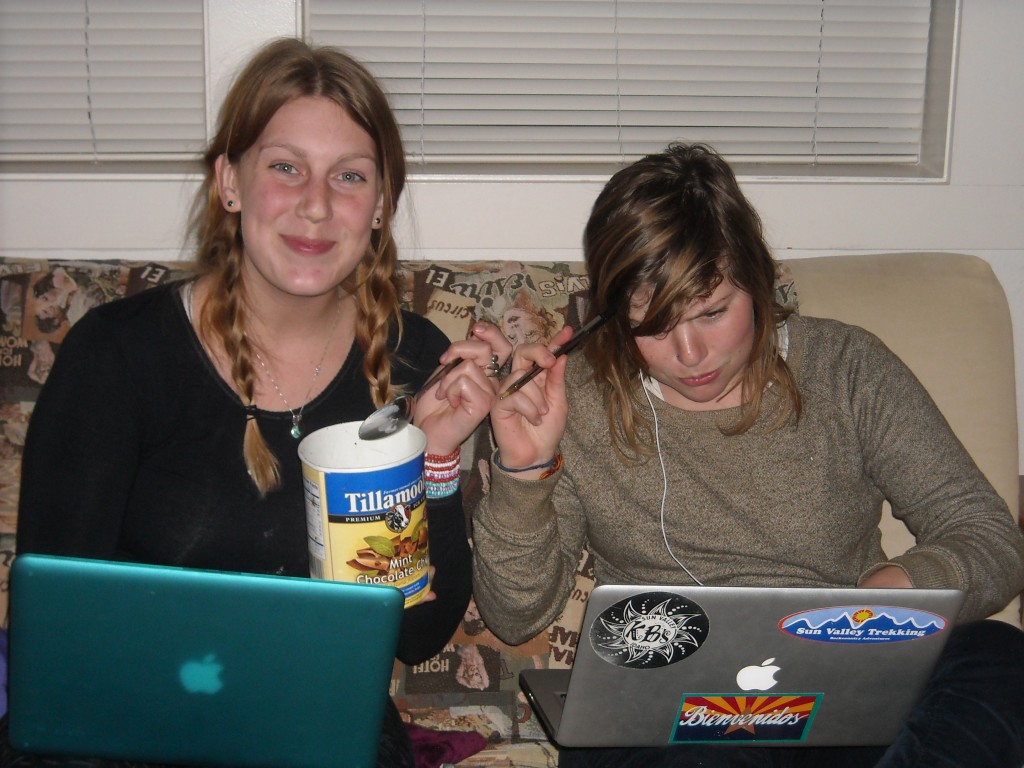
Bre and Jamey hard at work, sitting on Elvis the futon
In our down time, our exploration and discoveries continue! Jamey, Dana and I did a small study of our own. We found that it is difficult to defy gravity and run up a plastic slide on a playground, no matter what type of traction your shoes have. After a try or two, I managed to reach the top of the slide. Difficult it may be, but definitely not impossible! Tomorrow we are going to observe a necropsy on a harbor seal and I am so excited! The food is still delicious, the laughter is ever-present and I am still extremely content in my new favorite place, the San Juan Islands!
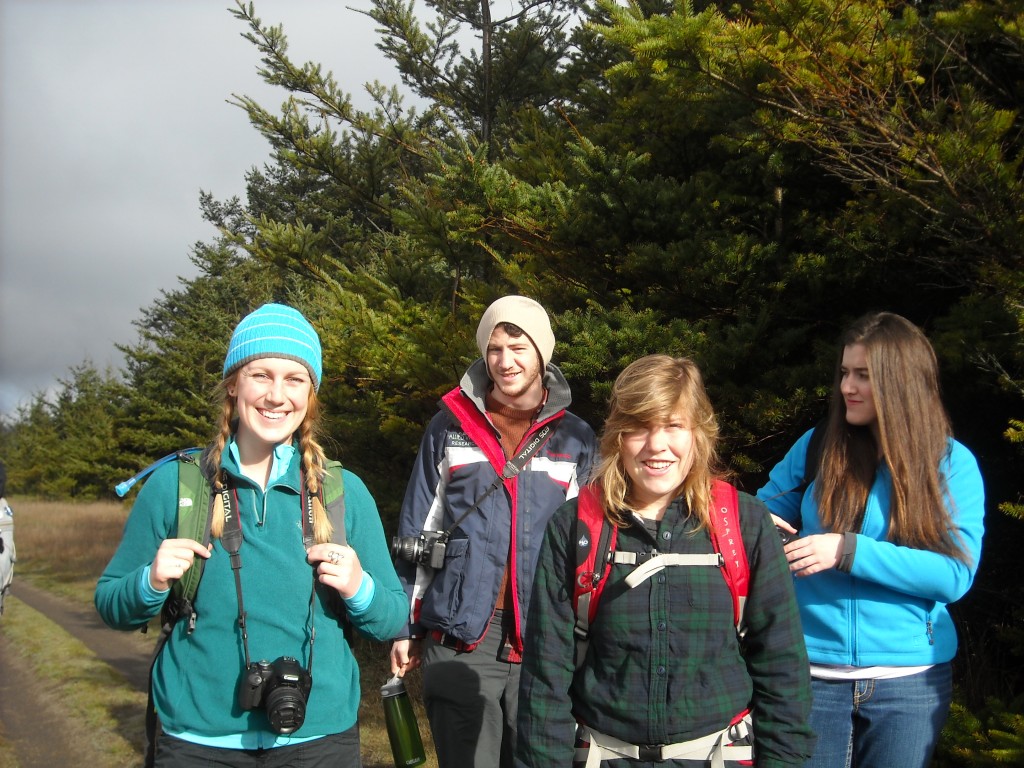
Bre, Phinn, Jamey, and Dana at South Beach where the trees smell like Christmas
Read More
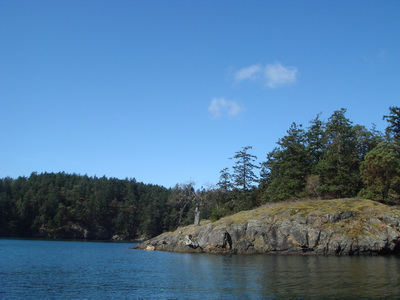
How did San Juan Island really look like 200 years ago?
Last Friday the S Pod had a case study discussion on sustainability. I chose an article entitled “Global Consequences of Land Use” by Foley et al, published in Science in November, 2005. The article pertains primarily to the effects of agricultural land use on land cover. One aspect I find intriguing is soil salinization, a phenomenon common in agricultural lands. Heavy irrigation of soil, coupled with removal of deep-rooted native vegetation, cause water table to rise near to soil surface. A disturbance such as heavy rainfall can then draw water levels to the root zone. When this water is evaporated from the soil surface, the salt is left behind, causing soil salinization, which quickly deteriorates soil quality.
Our Beam Reach instructor, Dr. Scott Veirs, mentioned that one common problem on San Juan Islands is the overwithdrawal of groundwater, causing salt water to seep into the aquifer. This led me to think more about the land and resource usage on San Juan Islands. In a conversation with Jason Gunter, owner of Discovery Sea Kayak, I found out that before English and American settlers arrived at San Juan Islands, the Native Americans practised controlled burning of open lands in order to better harvest bulbs. It has been speculated that at the time, many parts of San Juan Island were not forested. The theory is that controlled burning allowed slow-growing trees such as oak to mature. When controlled burning stopped, tall and faster-growing conifers such as Douglas fir out-competed the slower growing species by creating shades. These conifers propagated, which gradually brought about the landscape we see on San Juan Island today.
Jason has also mentioned that this change in land cover has caused the loss of a few species of birds. It would be very interesting to find out how land use and land cover have evolved for the past 200 years, and whether this has impacted the local nearshore or marine ecology in any way. Nonetheless, I think it is even more pertinent to study the current land and resource usage on San Juan Islands, in order to modify and adapt resource usage to ensure the continuous availability of these resources — such as potable water and fertile soil — in the future.
Read More
After a long week of work we were excited to finally get into town yesterday. We ate a quick lunch, and hopped into the rowboats for a short, and somewhat rambunctious boat ride into Friday Harbor. The Whale Museum was our first, and longest stop. For me the most fascinating part of the museum was the rich cultural connection between the Northwest Coast Native People and the orcas. This subject is of particular interest to me after working at Camp Nor’wester (http://norwester.org/) this past summer. Camp Nor’wester is lucky enough to be home to a native big house, and a Northwest coast Native education program, but until the Whale Museum I didn’t know the native stories of the orcas. After a fascinating hour and half at the museum we decided to mosey around town, and somehow stumbled upon the Sea Shepherd store. For those who don’t know Sea Shepard is an anti-whaling organization founded by Paul Watson. The show Whale Wars follows the organization’s campaigns down in the Southern Sea, where they fight the Japanese whaling fleet. Their methods of stopping the Japanese border on blurred line between eco-terrorism and radical activism, but they do seem to be effective. It just so happened that Peter Hammarstedt, captain of the Sea Shepherd Ship Bob Barker, was doing a meet and greet at the Sea Shepherd store! We got to meet him, and had a really interesting conversation about the role of science in environmental activism (apparently there not much room for it)! This discussion tied in extremely well to our readings and talks in class about sustainability science, and the role science plays in conservation work.
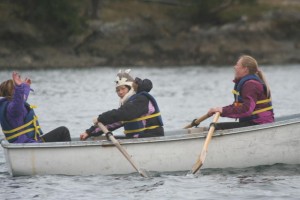
Last week the six of us each presented a case study on sustainability science, and discussed each paper in depth. I presented on a paper titled Rewilding and Biodiversity: Complementary Goals for Continental Conservation by Michael Soule and Reed Noss. This paper discusses the conservation method of rewilding, which aims at creating connectivity between isolated ecosystems. Rewilding is a fairly new technique used by conservation biologists to help preserve the key stone species, which typically are large carnivores, of isolated ecosystems. The concept of rewilding evolved from the theory of Island Biogeography, which was developed by Robert H. MacArthur and Edward O. Wilson in the late 1960s. Island Biogeography is he basic ecological concept that on any isolated environment (originally islands) the ecosystem has a maximum capacity of established species it can hold. The smaller the environment the less species it can sustain, and the higher the extinction rate. Because civilization has built up around many ecosystems, and essentially turned them into ecological “islands†the extinction rate has become much higher in these areas of isolation. Rewilding aims to reconnect these “islands†through wilderness corridors. These wilderness corridors are essentially highways of untouched land through which animals, namely large carnivores, can travel between.
Overall it has been an amazing first week, and I can’t wait to see what the future holds (hopefully whales!). I feel so fortunate to be in such a beautiful place, learning amazing things, with an incredible group of people!
Until next time,
Jamey
Read More



















 Twitter
Twitter LinkedIn
LinkedIn Facebook
Facebook